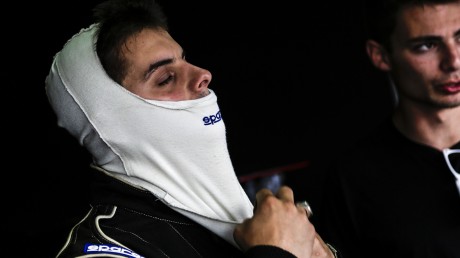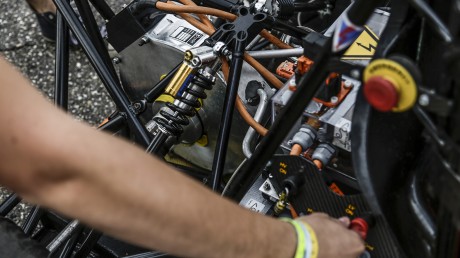Riccardo Damiano gives the thumbs up. Sitting in his race car, surrounded by the TU Darmstadt team, his car is being pushed back to the pits. One deep breath, and then the 25-year-old civil engineering student gracefully slides out of his nearly three-meter-long sports car. He removes his helmet. His black racing suit with narrow white stripes is a good match for the vehicle. In fact, the only difference is a few thin red lines that adorn the car. The team is ecstatic. Riccardo says, “I love the crisper handling of the chassis. It’s great!”

Just like the pros, Riccardo Damiano knows what matters most on the track.
Just two weeks ago, 11 Formula One teams shared the pit lane at the Hockenheimring. Now 115 racing teams have to squeeze into the same space. Working elbow to elbow, thousands of students, under constant pressure for six days straight, ticker on the cars, run tests, and consult with each other. They all want to show the world that they have built a race car that can deliver the best overall combination of design, manufacturing methods, performance, financial planning, and salesmanship at Formula Student Germany (FSG). Seven of the teams from a total of 25 countries are sponsored by Opel, including the team from TU Darmstadt.
Among the Top Three on the Skid Pad
Just like the pros, Riccardo Damiano knows what matters most on the track: “You have to be at one with the vehicle and avoid making too many adjustments to the steering.” This young man, who has the perfect build for a race car driver, that is, not too tall, slim, and in good shape, acquired the necessary feel for the car and a sense of speed early on: “I rode a children’s motorbike for the first time when I was eight, and later I got my motorcycle license.” His passion has paid off. On the skid pad, where drivers do figure eights on a wet course, he took third place. The proof is in: The team has developed one of the best cars in the field when it comes to static lateral acceleration.
A few meters away, Christian Butschek, another one of the 35 team members, is keeping a keen eye on the safety check. “I programmed the vehicle control unit and am the one responsible for diagnostics and adjustment controls.” The math student, with a full head of curly hair, is excited about the Formula Student project: “You learn how to work under pressure, how to communicate with specialists from different fields, and how engineers tick. This is a huge project that helps a lot!” The red lamp above the driver’s head lights up, indicating that power for the electric engines is on. “We’d rather perform one more test here in the pit, because once the car is ready to go, and something doesn’t work, that’d be embarrassing,” says the 25-year-old.

Seven of the teams from a total of 25 countries are sponsored by Opel.
The New Car Is 50 Kilograms Lighter
Richard Scholz, however, is sitting, red in the face, in his speedster in the pit of the RheinMain University of Applied Sciences Wiesbaden Rüsselsheim. He is visibly angry. The 30-member team has spent a year building the electric-powered race car. The prototype weighs 50 kilograms less than its predecessor. The wings have been removed, the cladding at the rear is gone, the undercarriage is smaller, and the frame weighs less. And now this: It took the driver with a strawberry blond beard twice as long as expected to complete the acceleration run, which requires the racing cars to accelerate as quickly as possible over a distance of 75 meters. Why did the ‘Hot Bee,’ as the Rüsselsheim students call their cars decked out in the black-yellow Opel colors, do so poorly?
“I had problems with the final speed,” Scholz hastens to add. “And with double-clutching.” “Well, keep your foot off the brakes,” suggests Jeffert Paulat, who is responsible for the pedals. “Step on the gas first, then lift up briefly before flooring it; otherwise the wheels will spin.” The team has one final shot at the acceleration run. Scholz has calmed down, and he is fully concentrated. Armin Dressler, with close-cropped hair and distinctive black spectacles, is a native of Rüsselsheim. This is his third FSG in a row. He is pushing the ‘Hot Bee,’ and Scholz in it, towards the start area. Spectators move aside to make room, and Dressler enjoys every moment of it. “This is what makes it all worthwhile.” For one week, all Opel teams were allowed to use the proving grounds at Rodgau-Dudenhofen and Pferdsfeld to conduct in-depth testing. “Then, we went back to the workshop and worked around the clock every day,” explains the 24-year-old engineering student. He designed the transmission for the car. The two round a corner where hundreds of fans are peering through the fence in the start and finish areas, with all eyes focused on the track. The pit lanes resound with the roar of the combustion engines. The electric drives give off a hum that gradually increases in pitch.

“Anyone who’s part of this will be ready for anything that could possible await them on the job“, says Udo Zuck. In recent months, he has been helping the teams sponsored by Opel any way he could.
Students Pass Their Test
Right at the starting line, there is Udo Zuck, an Opel employee from the manufacturing technology unit. In recent months, he has been helping the teams sponsored by Opel any way he could. “Anyone who’s part of this will be ready for anything that could possible await them on the job. The students have demonstrated their interdisciplinary thinking and ability to act, despite being under immense pressure. They’ve shown a lot of commitment.” He casts his eyes again on the track. “The Rüsselsheim guys are up again.”
Richard Scholz and his racing car are at the start. He is staring straight ahead. In his mind, he is going through the motions of his foot, which he must have down pat by now. The green flag is shown, and the ‘Hot Bee’ buzzes off. Spectators are craning their necks towards the monitor. After 4.64 seconds, the sports car reaches the finish line at a speed of 103 km/h. The team is happy with this time.
Back in the pit, the crew members are putting their heads together yet again. They are still working on finding the perfect setup. One thing is clear: The students have gas coursing through their veins, and are loving every second of it. (Matthias Voigt)
Formula Student Germany consists of two parallel competitions: Formula Student Combustion (vehicles with combustion engines) and Formula Student Electric (with electric engines). For both competitions, students work in teams to build a one-seater Formula One car. In 2014, there were 115 racing teams – 75 with combustion engines, 40 with electric drives – at the start of the Hockenheimring.
It is not necessarily the fastest car that wins, but the team with the best overall combination of design, racing performance, financial planning, and salesmanship. In preparing for the competition, students are given the task of building a prototype for a racing car, which could also be manufactured as a limited series edition. The teams go through the static disciplines of engineering design, cost analysis, and presentation of the business plan, followed by the dynamic disciplines of acceleration run, skid pad, autocross, fuel/energy consumption, and endurance racing.
For the first time in the history of Formula Student, seven partner teams were on the starting line for Opel: ‘Scuderia Mensa’ from the RheinMain University of Applied Sciences Wiesbaden Rüsselsheim, ‘DART Racing’ from TU Darmstadt, ‘HAWKS’ from the Hamburg University of Applied Sciences, ‘Fast Forest’ from the Deggendorf Institute of Technology, and three teams from the U.S. – ‘Ann Arbor’ from the University of Michigan, ‘Pomona’ from the California State Polytechnic University, and ‘Washington FSAE’ from the University of Washington.
The teams received a lot of support from Opel. They were given access to the proving grounds in Rodgau-Dudenhofen and Pferdsfeld to run tests and train. Mike Ableson, Head of Development, gave them final pointers before the race, while Opel lent its support in manufacturing parts such as rims. Finally, the teams received help with electrical engineering from Peter Andres, technical director for V2X communication).
For information and results, visit www.formulastudent.de